DESERT HIKE
In the dry, dusty, magical footsteps of giants — one day’s walk in Namibia
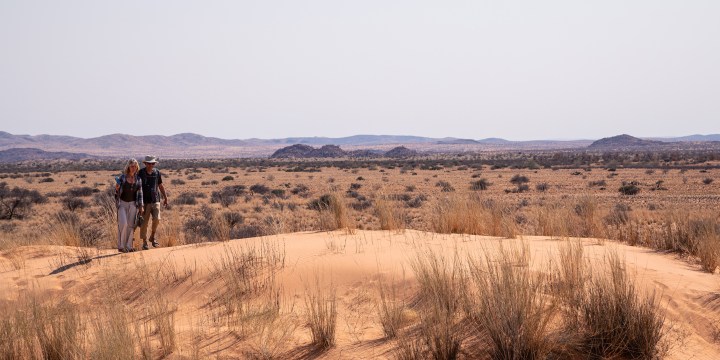
For some the desert landscape may come across as monotonous and the horizon never within reach, but all around the hiker are unobvious signs of life waiting to be discovered and marvelled at.
Walking without thinking is impossible even though the act of walking is partly automatic. The thinking part comes in because of our living chemistry being affected by this act. So, there I was, staring at an invitation to participate in a brand-new slackpacking exercise in the Sorris Sorris Conservancy in Namibia, courtesy of Madisa Camp.
The conservancy is in the Brandberg area of Namibia, closer to the west coast and just north of Henties Bay in terms of latitude. It is in the Damaraland region of the country. The Brandberg Mountain is the highest in the country and its highest peak is Königstein (2,573m). It has a rich history in terms of its geology, and its cultural and spiritual significance is exemplified by hundreds of rock paintings, “The White Lady” being a significant example.
The conservancy is nestled among, and on, a number of riverbeds (dry at the time of walking, thankfully). Madisa Camp is on the Goantagab River.
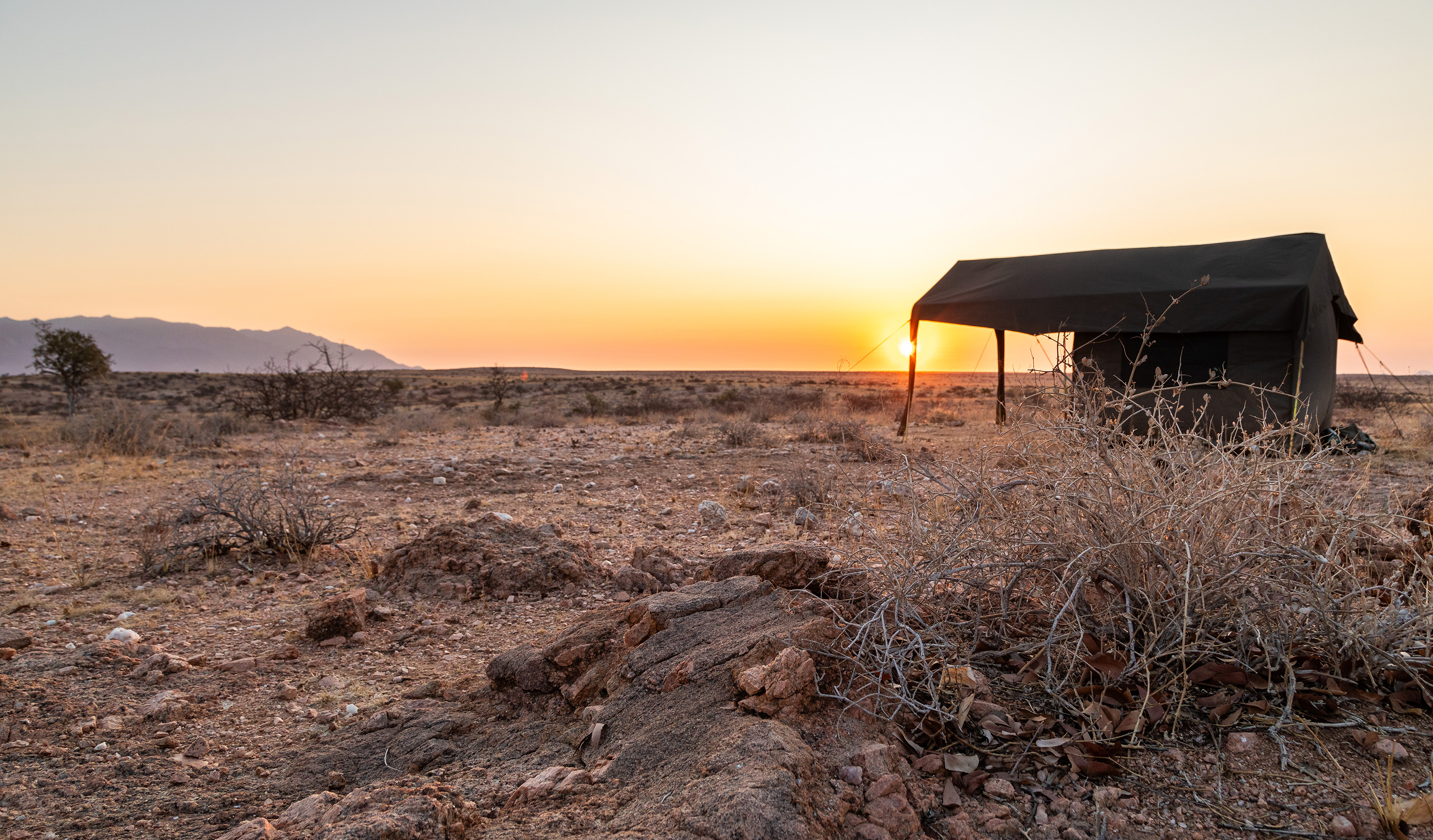
The writer’s tent for the first night – the tent he could not find – set against a beautiful desert sunset. (Photo: Le Roux van Schalkwyk)
For this specific escapade, the assignment was not just to walk, but for the five participants to trial a trail. In effect, doing a dry run of a new trail for the organisers to hone their skills for future walks.
The drive to Walvis Bay passes by Swakopmund to Henties Bay, after which is a beautiful road with some gravel parts. Friendly locals pointed us to the correct route and we arrived at the beautiful bush camp as the sun set. After discussing the programme for the next few days, it was off to bed. Our tents were spacious wonders with a bed, table and lamp, and I fell asleep with the thought of seeing wild elephants along the river.
There was, however, the troubling thought of two new bulls in musth as well as a number of baby ellies. We had been exhorted to be aware of the emergency communications by our guides, Kerneels and Jessica, two jewels in their own right. They were our ears and eyes on the trip, often seeing buck way in the distance, beyond the ability of my tired old eyes.
Day one
The walk started over soft sand, past Finger Rock, a sentinel for the whole of the first two days. The land is a cruel-looking panorama of grey-brown scrub punctuated by sparsely dispersed green trees or small bushes, and even the odd flower or two.
Our guides proved to be stars in showing us the unobvious signs of life, drawing from their deep indigenous knowledge about the flora around us. Various plant species were pointed out, including the shepherd’s bush tree and various others with medicinal properties.
The day of walking was always backdropped by the impressive sight of the Brandberg Mountain, an imposing presence. We ended the first day with cold beverages and excellent cuisine, quite in contrast to the harsh reality of the countryside.
That evening I was hard-pressed to find my tent because of failing batteries in my headlamp. Talk about forward planning. I felt such an ass, wandering in the dark like a rookie in a whiteout in Antarctica looking for base camp. I found it, though, owing to super-sleuthing involving a bumped toe and a frightening encounter with a low, unassuming bush. What would the new day bring?
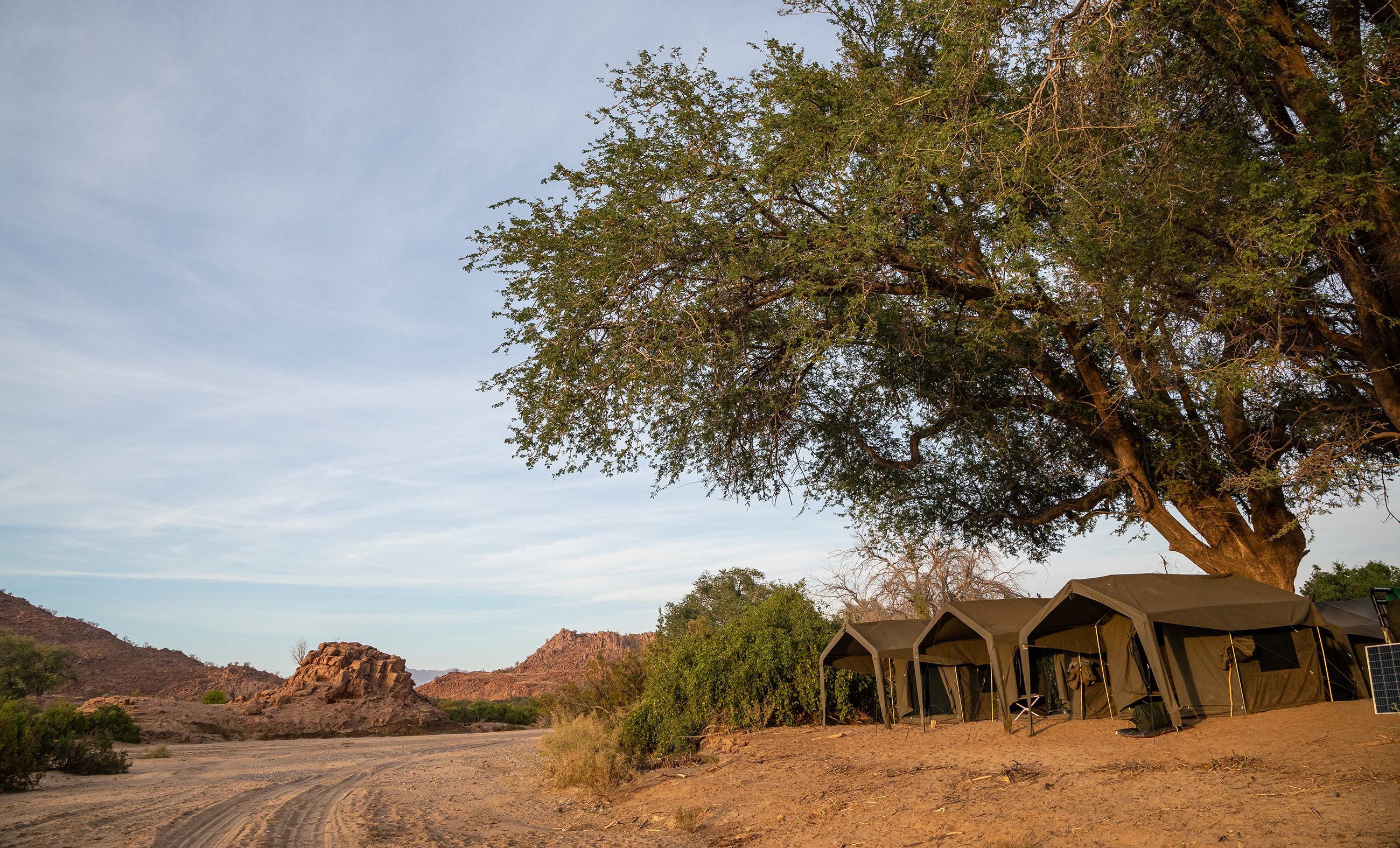
Old trees dwarf one of the makeshift campsites that were put up for this trial of a trail. (Photo: Le Roux van Schalkwyk)
Day two
Up and at ’em, I thought. Well, it’s largely what we did. We were headed towards a 15km finish line in the Ugab River with the prospect of elephants on the horizon in more ways than one. It was another amazing day with the Brandberg haunting us in the background.
We were retrieved upriver by our host in Bliksem, the sturdy four-wheel-drive vehicle.
We passed an informal settlement (that ubiquitous term in our South African lexicon) with an ornate memorial garden, properly constructed and protected.
We eventually were to walk 20km to our campsite, which we missed because of confusion about Elephant Rock being our target in the Ugab riverbed.
It turned out that there are two Elephant Rocks in the area. But we were retrieved upriver by our host in Bliksem, the sturdy four-wheel-drive vehicle.
An amazing sight was our first desert elephant called Benny, who had a collar with a tracker around his neck. Standing magisterially in the shade of a huge tree, he gave us the lazy eye as we gawked at his huge tusks.
The herd had moved downstream at this point, and Benny always brought up the rear as a backstop. This was mostly because of his being kicked out of the herd by the two younger bulls in musth.
Later that day, during my afternoon sleep, he came down towards our camp, giving everyone extensive photo opportunities.
A well-catered plankies meat and salads with dessert again rounded off the evening. For the uninitiated, plankies meat is a quickly turned, rare steak cut into slices on a cutting board. Just so’s you know. This time, I found my tent easily since I had inserted new batteries into my headlamp.
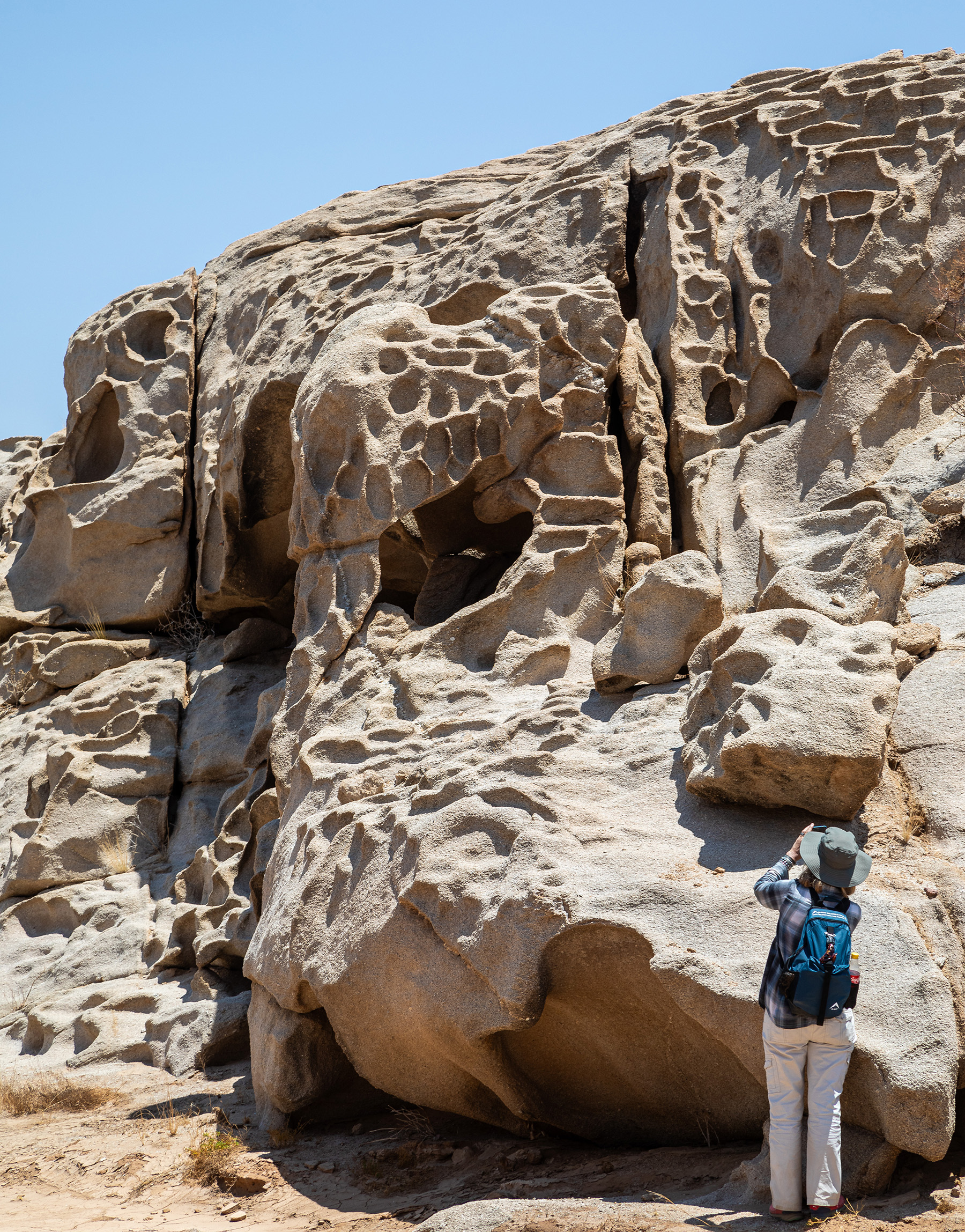
One of two Elephant Rocks in the vicinity. (Photo: Le Roux van Schalkwyk)
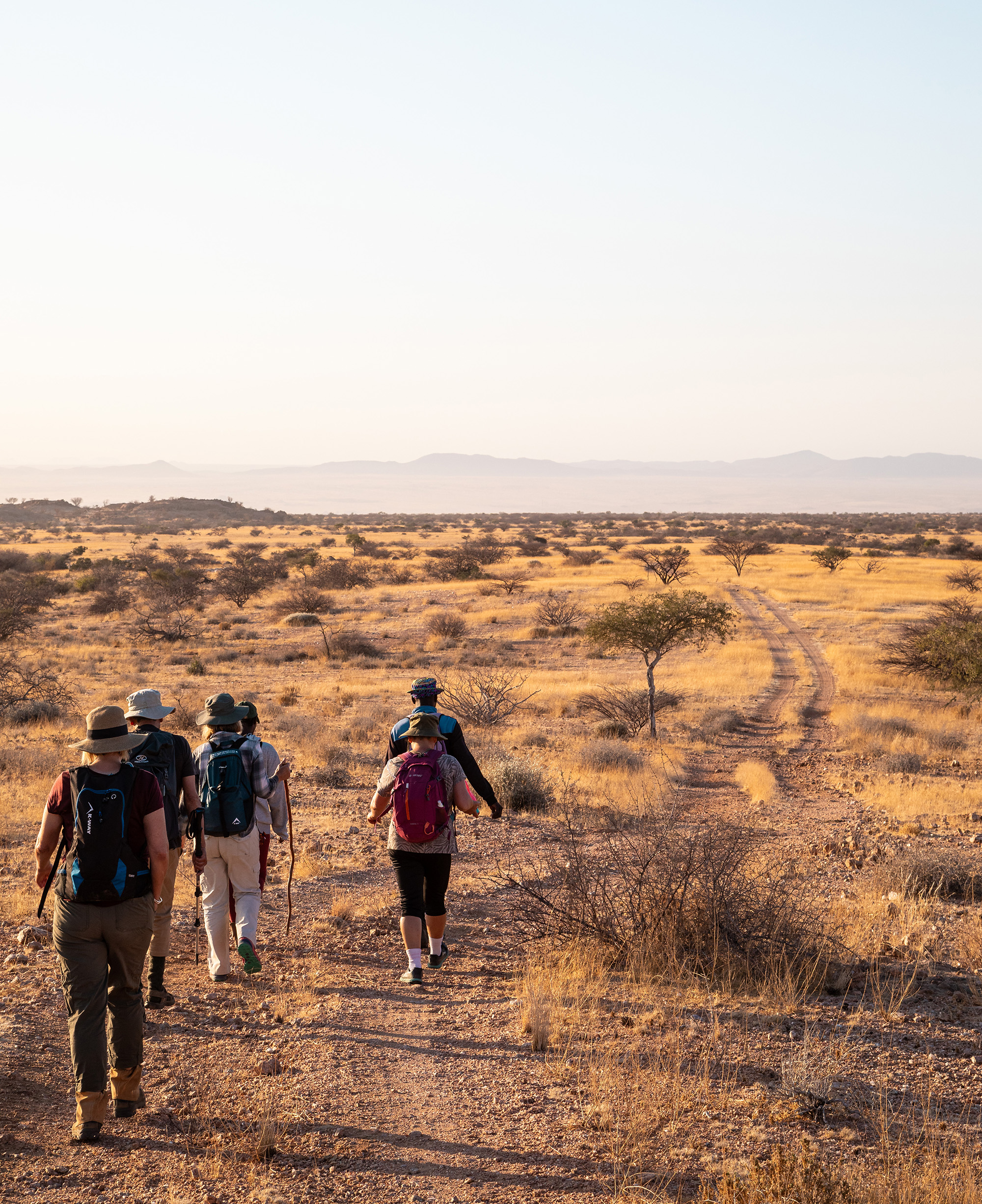
A not-so-quick march to them thar hills surrounded by typical desert vegetation. (Photo: Le Roux van Schalkwyk)
Day three
We all jumped out of bed the next day at 5.30am as usual, mostly in a sleepy, unwilling fashion. Reporting for duty was fortunately made bearable by the copious supply of hot coffee and rusks.
One thing about this walk was the great hospitality: A breakfast halfway into the walk, followed by a brunch on arrival at the end point and a supper in the early evening.
We walked along the sandy riverbed for most of the way with the expectation of a marshy area ahead. All along the way we saw elephant tracks and dung. Desert elephants, or in this case, “adapted” elephants, have a slightly larger footprint for ease of walking.
It eventually ended in a bullfight, with a few clashes of heads and street-type scuffles.
We were also treated to the sights of a porcupine hide and tracks, and the tracks left by snakes, buck, aardwolf, anteaters and other smaller creatures. We even saw the spot where an ostrich had its dust bath, with stray feathers remaining behind.
But more was to come as we headed through the swampy, marshy areas. Apart from having to make two wet crossings precipitated by the water seeping up from an underground source, we were confronted by the sound of a boom box. It was a rhythmic, low ululation, something akin to an expression of pain or a young man in love. And there they were: A dappled grey Brahman bull and another bull of unknown but fairly pedestrian lineage, but with a dangerous pair of curved horns. Facing off, they slowly wended their way towards us, in essence stopping our progress.
It eventually ended in a bullfight, with a few clashes of heads and street-type scuffles. Once they had passed we could make progress to our campsite. It was a tough slog through the sand, though, testing our tenacity. What a pleasure to hit camp with enough liquids to hydrate tired muscles after 19km of walking, making the total 58km to date.
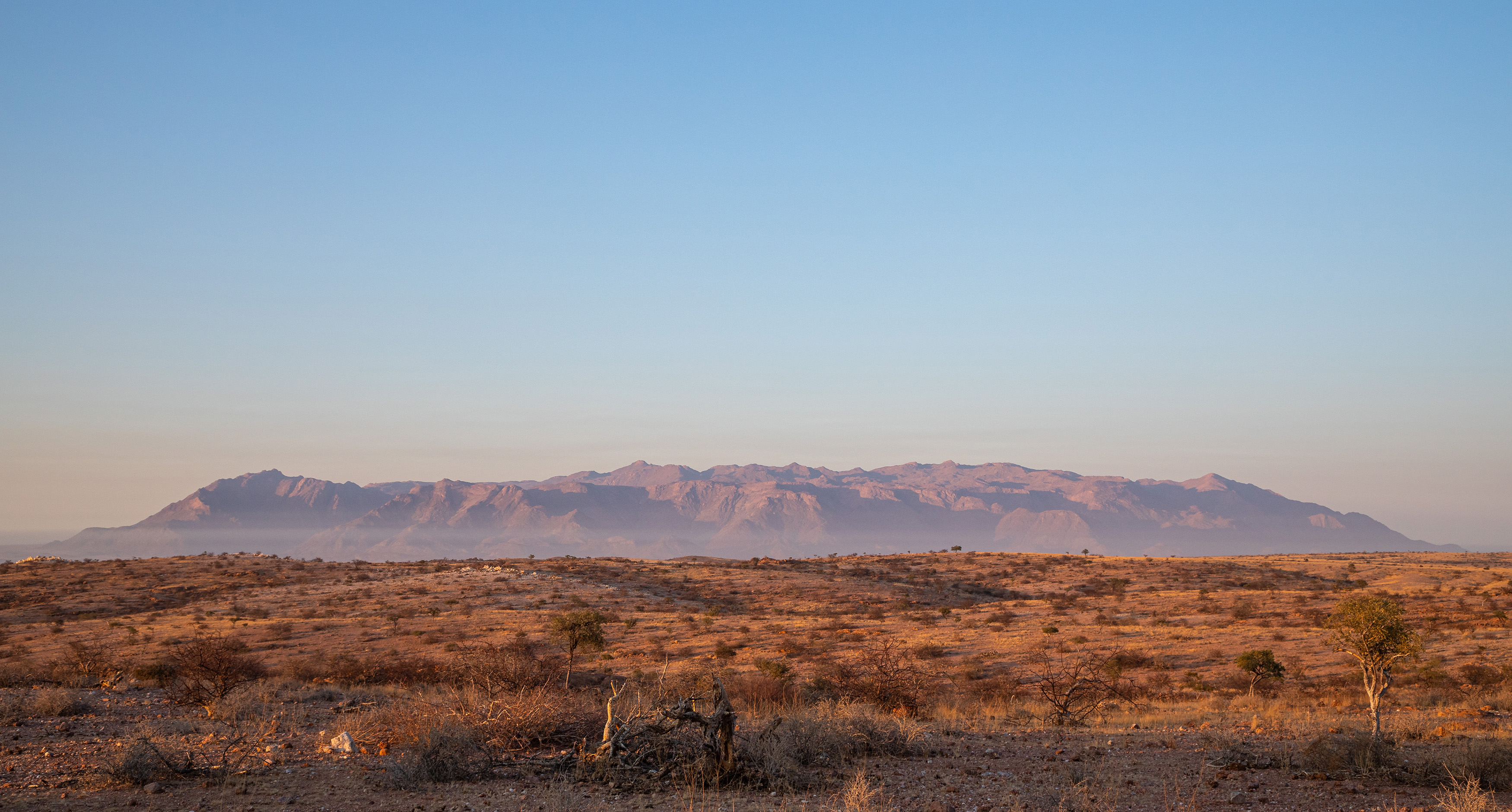
A majestic landscape of open plains with mountains in the background. (Photo: Le Roux van Schalkwyk)
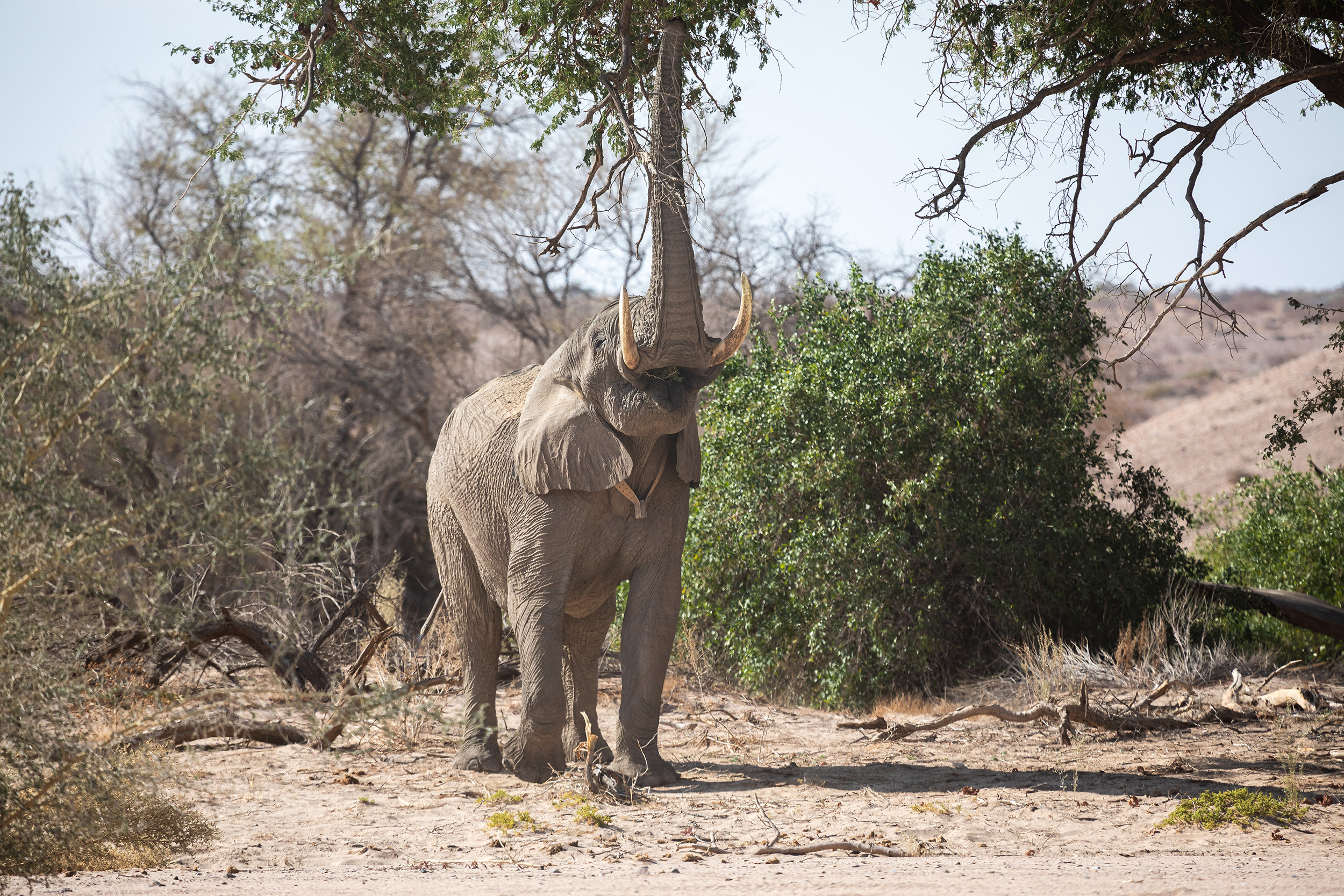
Benny, a desert-adapted elephant feeding on the riverbank opposite the campsite on day 2. (Photo: Le Roux van Schalkwyk)
Day four
After a night of wild and wonderful noises, some from the local fauna and many from tired walkers, we arose to the smell of bacon and eggs. While another African sunrise pleasantly assaulted the senses, we snarfed up the hot coffee and delicious breakfast. No rusks for us at this stage – we were going big and going home.
The prospect of a beautiful pool and cold drinks made the walking easy, with beautiful sunshine, a cool breeze and barking dogs on the back of the support vehicle. And the announcement of a shortened route of 9km sweetened the walking pot for everyone.
Slowly we reached the end point, another bittersweet one in my life, yet one which indicates that further adventure beckons.
This part of the world is like a magnetic north pole to my south pole. My own honey pot with endless natural diversions and surprises, all of them augmented by fellow walkers. Deep thoughts, deeper talk and a coming together of like minds.
And so we slowly walked, as a group, towards our final lunch spot, knowing that all was good and everything would be okay at the end. After a long sojourn under a most beautiful tree, our game-viewing transport vehicle came into view to take us back to our base camp.
Read more in Daily Maverick: At the heart of the Wild Coast are its people and their invaluable local knowledge
This, in itself, was epic. Swaying, bumping and grinding our way over sand was reminiscent of a sexy dance. We stopped at Camp Ehras (Elephant Human Relations Aid) to see the spring that sprung there, where a fabled python had once lived.
Finally, we arrived at base camp to hot showers and cold drinks. I wanted to live there forever. To top it all, the Rugby World Cup final played to a thrilling one-point win for the Springboks against France. Watching it on two cellphones with about 15 people of all nationalities was a strange experience in exotic surroundings.
Final thoughts: Dry, dusty, magical, radical, awe-inspiring beauty is written over the landscape in the beautiful setting that is Camp Madisa in the Sorris Sorris Conservancy. I will go there again if given half the chance. DM
For updates on dates for iterations of this walk in 2024, please contact Kelly on [email protected]
This story first appeared in our weekly Daily Maverick 168 newspaper, which is available countrywide for R29.
















 Become an Insider
Become an Insider
I absolutely enjoyed every word written in this article, painting pictures in my mind and reminding me of how absolutely astonishing and unique Namibia is. Every part, every section, every mountain, every rock and tree.. unique and diverse, and I longed to be there again! My solo journey during December 2020, driving 6500 km to explore Namibia for the first time was an exhilarating experience; the people I met, the terrain, the wildlife and of course 39 to 24 deg. Celsius heat driving through Etosha, without aircon in my car.. amazing though, how quickly we acclimatize and just focus on every little thing there is to see.. from the smallest ground squirrel to the largest tuskers I’ve ever seen.
Thank you for taking me on this journey again.. even though your story are simply beautiful pictures in my mind.. for now.. Until I too can return.